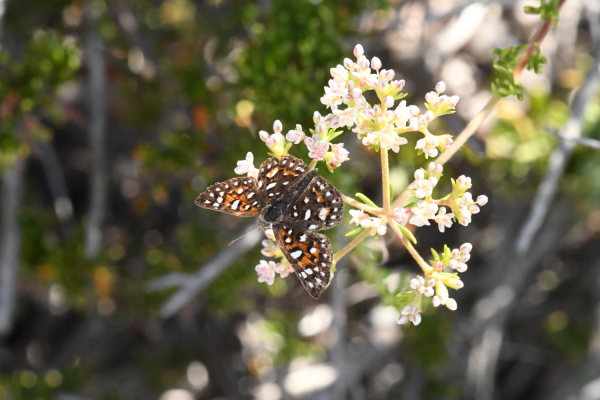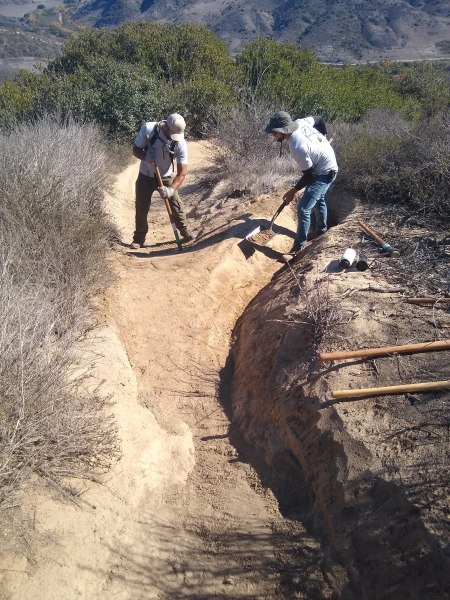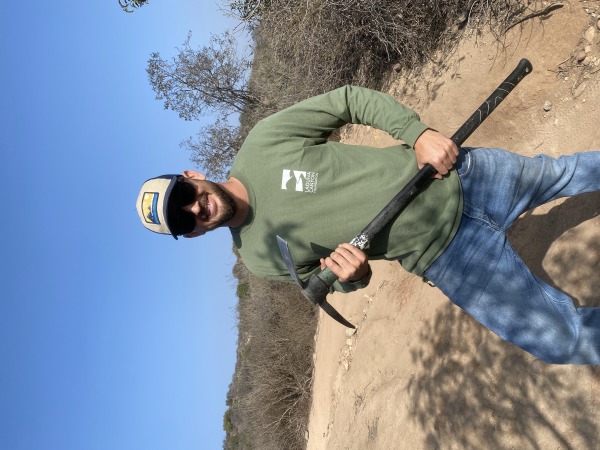The muscles in my arms are tiring. Thud. Thud. Slap. I strike the ground some more. The soil shudders as I release a succession of smacks with my tamping device. The California sun is beating on me as I dig, scrape, and carve out drainage features into the trail surface. I am maintaining the popular trail known as “Mentally Sensitive” in Aliso and Woods Canyons Wilderness Park. At this moment I am on my first week working as Trails Outreach Coordinator for the Laguna Canyon Foundation. Two others are working with me: Alan, our Director of Conservation Programs and Jeremy, a long-term volunteer. My goal at this moment is to learn how to improve a trail and how to spot signs of trail deterioration.
When I began the job three months ago, I thought of trail maintenance as recreation infrastructure, now I realize it it’s more – it is habitat conservation.
When I tell people I work on trail maintenance I often get perplexed looks. I might as well have said that I stack rocks professionally. As an avid hiker and now an experienced trail steward, I’m assailed by the need to elaborate: a trail is the result of thought, design, and hours of sweat and toil.
We have all had the experience of going out into the wilderness and finding that the trail we are walking on is so rutted out or muddy that we must skirt the edge rather than walking atop it. In doing so we may crush small plants or break or crumble the soil adjacent to the trail. Others will later follow the same detour and over time the soil adjacent to the trail will become bare, creating a new path devoid of vegetation. When this happens dozens of times over the course over a miles-long trail the impact adds up.

This loss of vegetation means a reduction in both food and shelter for wildlife of the area. This does not just mean a loss of habitat for nature store favorites, like deer and bobcat, but for a whole animal community ranging from arthropods, birds, reptiles, to small mammals. For example, California buckwheat, a modest little shrub, is an important pollinator for at least five species of butterfly and several native bee species. It is also critical habitat for the endangered California gnat catcher. Poison oak, although hazardous to humans, produces berries and shelter for the California towhee. These are just a few examples of animals that depend directly on our vegetation. In turn these animals, are prey to others higher in food chain. Left unchecked, increasing trail size chips away at our native vegetation eventually having consequential impacts on the overall ecosystem health. A happy trail does not just mean happy hikers and cyclists, it means a happy environment.
Keeping the trail appealing for those hikers and cyclists is quite a challenge. In my job two tasks stand apart as most common: brushing and drain maintenance.
Brushing is the process of trimming the branches and leaves that grow into the trail. This is done with loppers, hedge trimmers, and pruning shears. The importance of this task is two-fold. First, it prevents users from unwittingly getting wacked in the face by a branch. Secondly, plants that jut into the trail force users to detour the designated trail and damage surrounding habitat.

The other common trail task we conduct is drain maintenance. Trails are places that naturally aggregate water during downpours. If allowed to collect, the water may follow the course of the trail creating a stream and rutting out the path. This can convert a perfectly usable trail it into matrix of canyonettes or mud puddles. To avoid this phenomenon trail stewards will create small channels called drains that allow the water to sheet off the trail before rutting it out. In addition, we make small mounds of compacted earth that stretch diagonally across the trail. This prevents water from continuing down the trail. To further encourage the water to exit we also dig a small low trench just uphill from the mound. This combination of mound and trench is called a rolling grade dip.
Despite all this work, we see the use and creation of unauthorized trails. The impact to habitat is significant. First, it fragments otherwise unbroken habitat, creating opportunity for invasive species to spread. Second, some species prefer larger areas of unbroken habitat, which is now reduced. Third, to carve a new trail one must trample native vegetation in the first place. Lastly, as land managers, OC Parks is required to get approval from governing bodies before any additional trails are authorized.

One might then ask, why allow users into the parks at all if even authorized trails require upkeep and cause a certain level of habitat loss anyway? This is answered by Laguna Canyon Foundation’s slogan, “protect what you love.” We believe that people are more likely to advocate for things they have a positive relationship with. Allowing users to connect with the outdoors bridges that connection humans and nature. We also want people to get out and experience the beauty of the wilderness, to feel the terrain by riding down the slopes, to hear the calls of the scrub jays, and to savor the smell of the California sagebrush. Yes, being outside intrinsically causes a degree habitat damage but it is better concentrate human activity into a few well-maintained designated trails than to create new ones.
Finally, has familiarizing myself with trail work changed my personal hiking experience? I can safely say no. I admit, I now notice poor trail design and maintenance needs. But, if anything, it has made me appreciate the effort and the time that go into trail work. It has also made me a better trail user; I avoid stepping off the trail and using unauthorized trails. It has allowed me to appreciate that good trail maintenance is not just recreation management it is another branch of environmental stewardship. As such, it is my goal as our Trails Outreach Coordinator that users of the South Coast Wilderness and Aliso and Wood Canyons Wilderness to leave a light footprint, literally.
